Last updated on February 28th, 2022 at 06:17 pm
Have you ever wondered why there are so many different cable types in audio, and how they work?
In this post I will explain the differences between balanced and unbalanced cables, how they work, and more.
Just note that using the right cable can have a major impact on what the sound quality is going to be like, meaning that you should know when to use a balanced- or unbalanced cable.
Let’s get straight into it…
Balanced Cables vs Unbalanced Cables
Balanced cables can “phase out” any outside interference because of the way they are built, which means that they will yield a much cleaner signal than unbalanced cables, especially when long ones are used since the longer the cable, the more interference it will be susceptible to, and balanced cables deal with this issue very well.
That’s the shortest explanation I can give, however, there’s much more to it which I’ll get to right now.
Unbalanced Cables; How do they work?

Unbalanced cables only have two conductors and two wires in them; one for the signal and one for the ground.
This is how your typical electric guitar cable is built.
It’s fairly easy to identify unbalanced cables by the number of connectors they have.
For example; a TS guitar cable, which stands for “Tip” and “Sleeve”, only has two conductors, or if you look at an RCA cable, you’ll also only be able to see two.
When taking a look inside the cable you’ll see that the wire that carries the signal is in the center, while the ground wire surrounds it, and the whole point of this is to shield the signal cable from outside interference, such as radio waves, transformers, lights, etc. which it does… to some degree.
Where does the noise come from?
The thing is that the ground wire itself acts a bit like an antenna, which means that it will be picking up noise along the way, and the longer the cable, the more noise it will pick up.
Unbalanced cables aren’t good for doing long cable runs for this reason, in fact you should be using balanced ones if the cable needs to be more than 10-15 meters long.
This is especially true if it needs to be used in an environment where there’s a lot of lights, power cables, and other electrical elements that could cause interference.
Note: If unbalanced cables absolutely need to be used, a good technique to minimize the amount of noise getting picked up is by managing the placement of the cables the correct way; a single perpendicular crossing of power- and audio cables is much better than having them run side by side.
This is because the audio cable will only be able to pick un that interference where the cables come into contact.
What are the most common types of Unbalanced Cables?
TS Cables: TS, or “Tip-Sleeve” cables are probably the most common unbalanced cables.
They are typically used by guitar and bass players to connect the guitar to the amp or pedalboard, as well as connecting the pedals on the pedalboard itself.
RCA Cables: RCA cables are typically used to connect devices like VCRs and DVD players to a TV, as well as connecting CD players to the stereo receivers.
Balanced Cables; How do they work?

Balanced cables have three conductors and three wires, and if you remember correctly, unbalanced cables only have 2.
This means that one of those wires is just the ground while the other two are responsible for carrying the audio signals.
Balanced audio cables are much better for doing long cable runs because they are much less susceptible to picking up any noise or interference.
But why is this?
Imagine you’re singing into a microphone which, like most microphones, is connected to an XLR cable.
XLR cables are balanced cables, which is why they have three pins; two for the signal and one for the ground.
Instead of just one “image” of the signal travelling through the cable, you got two identical copies of it, with one copy going through each signal wire.
But the trick is that one of those gets inverted, meaning that it’s now out of phase with the other signal, effectively canceling each other out.
This means that if you try to play back both the signals that are travelling through the cable you wouldn’t be able to hear anything…
However, when the signal gets to the other end of the cable, the polarity of the signal that was out of phase gets flipped around again, and now both the signals are back in phase.
The cool thing is, and this is why I think that balanced cables are incredible, that any interference that was picked up by the cable will now be cancelled out because of that last polarity flip.
This means that you could virtually run as long of a balanced cable as you’d like without picking up any noise or interference whatsoever and just be left with the original signal.
What are the most common types of balanced cables?
XLR Cables: XLR cables are typically used with microphones for the reasons I just explained, plus they can carry phantom power through pins 2 and 3, which is used to power the circuitry in condenser microphones.
TRS Cables: TRS stands for “Tip” “Ring” and “Sleeve” which are the contact points and are separated by two insulator rings. The sleeve carries the ground in this case.
Now, this is a question that I heard many people ask…
Are balanced cables designed to carry a stereo signal?
One common misconception is that balanced cables are actually used to transmit a stereo signal, which they can do, but’s it’s not ideal.
Why is this?
If you decide to run a stereo signal through them, then the right signal will be sent through one wire and the left one through another.
But in this case, they would end up working like a regular unbalanced cable, which is far from their original purpose and they wouldn’t be able to phase out any interference.
Can you use unbalanced cables with balanced Equipment?
You can definitely use unbalanced cables with balanced equipment, however you won’t get all the benefits that a balanced cable provides since they can’t carry an out of phase signal.
This means that the signal will still be carried across the cable to the receiving gear, but the overall noise level might be higher.
Basically, if you’re using balanced gear, try to use a balanced cable.
Can you use a Balanced TRS cable as an unbalanced TS cable?
Unbalanced TS cables should be used with unbalanced inputs and outputs, however, TRS cables can be used as a replacement, but the signal won’t be a balanced one, but rather unbalanced.
This means that again, you won’t be benefitting from using a balanced cable in this case.
Basically, you can use balanced cables with unbalanced gear, which will give you no benefit at all, and you can use unbalanced cables with balanced gear which will work, meaning that the audio signal will reach the other end, but there might be more noise.
Are XLR cables better than RCA?
XLR cables carry a balanced signal while RCA cables can only carry an unbalanced one, and there are some sonic benefits to balanced signals, such as less hum and noise, and less overall audio degradation. If you have the option of using an XLR or an RCA connection, always use the XLR one for best results.
And lastly…
Difference in Cost
One of the reasons you might be inclined to choose an unbalanced cable over a balanced one, especially if you need to purchase more than one, is the cost.
Balanced cables cost a lot more than unbalanced cables, sometimes even twice as much, simply because of the added benefit of providing a cleaner signal.
However, if you’re out to save money, then unbalanced cables might be your best choice, especially if you’re just using really short ones.
Conclusion
Balanced cables are fantastic and the way they work is really interesting, at least to me.
Try to use the right cable for the right application, otherwise you won’t get the benefit of running a balanced one… like I just mentioned above.
I hope this information was useful…
Have a fantastic day!

Thank you for taking the time. You explained that really well, and I had no idea.